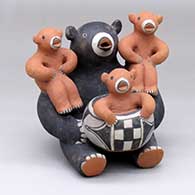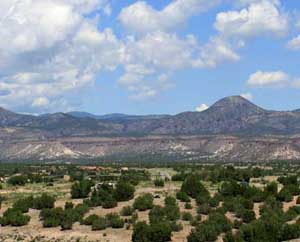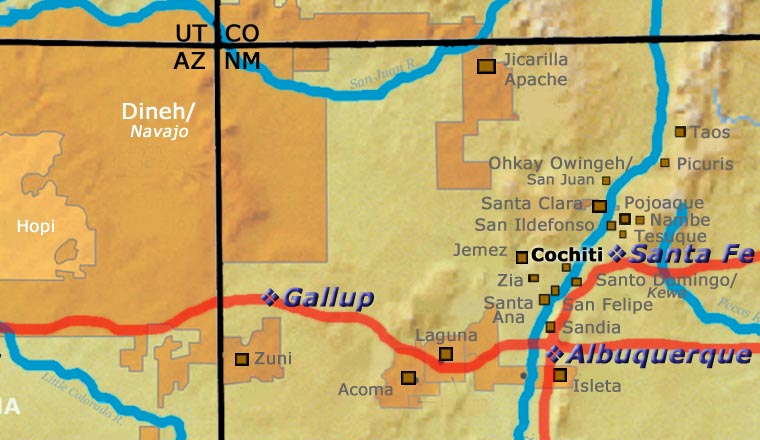
Louis Naranjo
1932-1997
Cochiti

Louis Naranjo was the son of Frances Naranjo Suina. Louis was born at San Ildefonso Pueblo, but when his mother married into Cochiti Pueblo and moved to her new husband's home there, he went as well. Louis grew up at Cochiti and watched as his mother learned how to make Cochiti pottery. However, during those years he showed no interest at all.
Louis married Virginia Arquero (daughter of Salvador and Evaline Arquero, niece of Juanita Arquero) in 1961 and she learned how to make pottery from watching and working with Louis' mother, Frances. She got really good at it and won a number of prestigious awards. Then she suffered a stroke.
While recovering from the stroke, Virginia and Frances taught Louis how to make pottery. He, too, excelled at the craft. Louis is credited with creating the first Bear Storytellers. Legend has it that, during a hunting trip, he unexpectedly came upon a mother bear playing with her two cubs. He ran to safety, but in those few seconds he noticed their sweet interactions. That contact inspired him to make bear storytellers. Sometimes Louis would collaborate on a piece with Virginia, sometimes with their daughter, Pauline. Usually, though, he worked on his own.
According to Southern Pueblo Pottery, 2000 Artist Biographies, Louis won an impressive string of ribbons at the Santa Fe Indian Markets between 1983 and 1996 with his innovative storyteller figures.
100 West San Francisco Street, Santa Fe, New Mexico 87501
(505) 986-1234 - www.andreafisherpottery.com - All Rights Reserved

Cochiti Pueblo

View west across Cochiti Pueblo
Cochiti Pueblo lies fifteen miles south of Santa Fe along the west bank of the Rio Grande. Frijoles Canyon in what is now Bandelier National Monument is the site of the pueblo's most recent ancestral home. The Eastern Keresans may have relocated to the Bandelier area from the Four Corners region around 1300.
Cochiti legend says that Clay Old Woman and Clay Old Man came to visit the Cochitis. While all the people watched, Clay Old Woman shaped a pot. Clay Old Man danced too close and kicked the pot. He rolled the clay from the broken pot into a ball, gave a piece to all the women in the village and told them never to forget to make pottery.

At Bandelier National Monument
In prehistoric times, human effigy pots, animals, duck canteens and bird shaped pitchers with beaks as spouts were common productions of the Cochiti potters. Many of these were condemned as idols and destroyed by the Franciscan priests. That problem stopped when the Spanish left in 1820 but the fantastic array of figurines created by Cochiti potters was essentially dormant until the railroad arrived. Then Cochiti potters were among the first to enter the tourist market and they produced many whimsical figures into the early 1900s. Then production followed the market into more conventional shapes.
Legend has it that a Ringling Brothers Circus train broke down near Cochiti Pueblo in the 1920s. Supposedly, the tribe's contact with the ringmaster, trapeze artists, opera singers, sideshow "freaks" and exotic animals paved the way for a variety of new figural subjects. However, shortly after the railroad passed through, a delegation of Cochiti men got on the train and traveled to Washington DC. There they were introduced to the President, spoke to Congress, and were taken on a tour of the "highlights" of American civilization in Washington and in New York City, incuding the Metropolitan Opera, the Bronx Zoo and a performance of the Ringling Brothers Circus. As none of the men could read or write, nor draw, what they brought back to Cochiti was what they remembered of things they had never seen before. The stories they told must have been wild. An astute observer will find angels, nativities, cowboys, tourist caricatures, snakes, dinosaurs, turtles, goats, two-headed opera singers, clowns, tattooed strongmen, Moorish nuns and even mermaids in the Cochiti pottery pantheon, many produced only since the early 1960s and based on characters described in Cochiti's oral history.
A few modern potters make traditional styled pots with black and red flowers, animals, clouds, lightning and geometric designs but most Cochiti pottery artists now create figurines. Most notable is the storyteller, a grandfather or grandmother figure with "babies" perched on it. Helen Cordero is credited with creating the first storyteller in 1964 to honor her grandfather. The storyteller style was quickly picked up by other pueblos and each modified the form to match their local situation (ie: clay colors and tribal and religious traditions). In some pueblos, storytellers are also now made as drummers and as a large variety of animals.
Today, Cochiti potters face the challenge of acquiring the clay for the white slip. Construction of Cochiti Dam in the 1960s destroyed their primary source of their trademark white slip and gray clay. Now the white slip comes from one dwindling source at Santo Domingo, Cochiti Pueblo's neighbor to the south.
Most outsiders who visit Cochiti Pueblo these days do so on the way to or from either the recreation area on Cochiti Lake or Kasha-Katuwe Tent Rocks National Monument.
100 West San Francisco Street, Santa Fe, New Mexico 87501
(505) 986-1234 - www.andreafisherpottery.com - All Rights Reserved

Frances Naranjo Suina Family Tree
Disclaimer: This "family tree" is a best effort on our part to determine who the potters are in this family and arrange them in a generational order. The general information available is questionable so we have tried to show each of these diagrams to living members of each family to get their input and approval, too. This diagram is subject to change should we get better info.
Frances was born into San Ildefonso Pueblo but she was orphaned before she was one year old. She was raised at the St. Catherine's Orphanage and St. Catherine's Indian School in Santa Fe. She married a Mr. Naranjo and they had a son but it didn't work out. Then she married a Mr. Suina and moved to his home at Cochiti Pueblo.
- Virginia Naranjo (1932-) & Louis Naranjo (San Ildefonso)(1932-1997)
- Mary Edna Trujillo (1965-)
- Pauline Naranjo (1969-)
- Dale Naranjo
- Jeremy Naranjo
- Michelle Naranjo
Some of the above info is drawn from Southern Pueblo Pottery, 2000 Artist Biographies, by Gregory Schaaf, © 2002, Center for Indigenous Arts & Studies. Other info is derived from personal contacts with family members and through interminable searches of the Internet and cross-examination of the data found.
(505) 986-1234 - www.andreafisherpottery.com - All Rights Reserved
